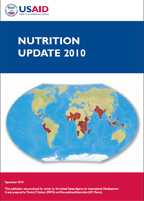- FEATURED

How does DHS collect data on anemia?
Anemia is routinely diagnosed with a blood test. The DHS Program tests women (15-49 years) and children (usually 6 months up to 5 years) for anemia through finger prick or, in the case of young children, heel prick blood testing using the HemoCue blood hemoglobin testing system. Testing is voluntary and respondents receive the results of their anemia test immediately, as well as information about how to prevent anemia.
Anemia testing in The DHS Program surveys provides a cost-effective opportunity to estimate the prevalence and differentials in levels of anemia within the populations surveyed.
Where can I find anemia data for a country?
Final DHS reports: Information from surveys with anemia questions or testing can be found in the individual country report chapters on nutrition. Anemia testings are not conducted in all countries.
How can I compare anemia data among countries?
Nutrition Update 2010 compares anemia in children and women for 36 countries.
STATcompiler allows you to pick and chose your countries and anemia prevalence.
Which DHS indicators are specific or relevant to anemia?
Prevalence of anemia in women (pregnant or not) and children: Anemia status is reported by hemoglobin levels ranging from any anemia, mild anemia, moderate anemia, and severe anemia:
- Percentage of children age 6-59 months with anemia
- Percentage of women age 15-49 with anemia
- Prevalence of anemia in children by anemia status of mother
These indicators are available in STATcompiler. Compare these indicators among countries and look for country trends.
Iron supplementation of children and women:
- Percentage of children age 6-59 months who received iron tablets/syrup/sprinkles in the seven days preceding the survey
- Percentage of women age 15-49 with a birth in the five years preceding the survey who received any iron tablets or syrup during pregnancy for the most recent birth
- Percentage of women age 15-49 with a birth in the five years preceding the survey who took iron tablets/syrup for 90 or more days during pregnancy for the most recent birth
Why is it important to collect data on anemia?
Anemia is a major public health problem throughout the world that impacts social and economic development. In developing countries, nearly half of all women and children are anemic, with the highest overall rates being reported in Southern and Central Asia and certain regions of Africa.
The main causes of anemia include low intake and absorption of iron from the diet, malaria, and intestinal parasites such as hookworm. Anemia in children has been associated with impaired cognitive performance, motor development, coordination, language development, and scholastic achievement. Anemia in women reduces their work productivity and places them at risk for poor pregnancy outcomes including increased risk of maternal mortality, perinatal mortality, premature births and low birth weight.
Consumption of food rich in iron is essential for the prevention of iron deficiency anemia. It is also important to avoid consuming iron absorption inhibitors such as tea and coffee during meals. Animal-source foods such as red meat contain the highest amounts of the most easily absorbed iron. Other foods with high iron content are green, leafy vegetables; dried beans; dried apricots, prunes, raisins, and other dried fruits; almonds; whole grains; and yams.
For vulnerable groups with high iron requirements such as young children between 6 and 24 months and pregnant women, it is difficult to meet iron needs through diet alone, even if some foods are fortified with iron. At these points in the life cycle, it may be necessary to take iron supplements to prevent or correct iron deficiency and anemia.
In settings with endemic or epidemic malaria, prevention and treatment of the disease will be critical for reducing anemia prevalence. Similarly, where hookworm and other intestinal parasites are endemic, children and women should receive prophylactic de-worming medication.
photo credit: ICF International
Featured Publication
Online Tool

Prevalence of anemia in women and children is available in STATcompiler; compare among countries and analyze trends over time.
